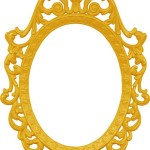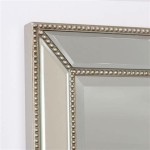How Do You Attach Wood to a Mirror?
Attaching wood to a mirror requires careful consideration of the mirror's fragility and the desired aesthetic. Several methods offer secure attachment while minimizing the risk of cracking or damaging the reflective surface. Choosing the right method depends on the size and weight of the wood, the type of mirror, and the overall design goals.
1. Using Mirror Adhesive
Mirror adhesive, also known as mirror mastic, provides a strong bond specifically formulated for use with mirrors. This adhesive avoids the use of screws or nails that can stress the mirror and cause cracking. Before application, ensure both the wood and the mirror surface are clean and dry. Apply the adhesive in dots or lines to the back of the wood frame or mounting cleats. Then, carefully position the wood onto the mirror, applying even pressure. Follow the manufacturer's instructions for drying time and support mechanisms.
2. J-Channels and Clips
J-channels are metal or plastic tracks designed to grip the edges of a mirror. These channels can be attached to the wood frame first, and then the mirror is slid into place. Alternatively, clips designed specifically for mirrors can be used. These clips often have a soft lining to protect the mirror's edges. They are attached to the wooden frame, and the mirror is then secured within the clips. This method offers good support and is suitable for larger mirrors.
3. Mechanical Fasteners with Backing
While direct screwing into a mirror is generally discouraged, mechanical fasteners can be used if a strong backing is added to the mirror. A plywood backing, for example, provides a solid surface for screws to grip without putting stress on the mirror itself. The plywood backing can be attached to the mirror using mirror adhesive. Once the adhesive has cured, the wood frame can be securely screwed to the plywood.
4. Wood Glue for Small, Lightweight Applications
For very small and lightweight wood pieces, wood glue can provide a suitable bond. However, this method is best reserved for decorative elements rather than structural support. Ensure the glue is compatible with both wood and the mirror backing. Apply a thin layer of glue to the wood and carefully position it onto the mirror. Clamping the wood in place while the glue dries is crucial for a strong bond.
5. Silicone Sealant: A Flexible Option
Silicone sealant offers a flexible and waterproof bond, making it suitable for bathroom mirrors and other applications where moisture might be a concern. Like mirror adhesive, silicone sealant is applied in dots or lines to the wood. Press the wood firmly onto the mirror and allow the silicone to cure completely before removing any support. Choose a neutral-cure silicone sealant to avoid potential damage to the mirror's silvering.
6. Constructing a Frame with Mirror Supports
Building a frame around the mirror with integrated supports is an effective method, especially for larger or heavier mirrors. The frame can be constructed from wood and designed with ledges or recesses to accommodate the mirror's edges. These supports prevent the mirror from shifting and distribute weight evenly. Mirror adhesive or clips can be used in conjunction with the frame for added security. This method offers both a decorative and functional solution.
7. Considerations for Different Mirror Types
Different types of mirrors require specific considerations. For example, antique mirrors often have thinner, more fragile glass and require extra caution. Using excessive pressure or inappropriate adhesives can easily damage these delicate mirrors. Similarly, beveled mirrors require careful handling to avoid chipping the edges. When working with specialized mirrors, consider consulting a professional for advice on the best attachment methods.
Preparing the surfaces is vital regardless of the chosen method. Thoroughly clean both the wood and the mirror surface with a glass cleaner or isopropyl alcohol to remove any dust, grease, or fingerprints. This ensures optimal adhesion and prevents contaminants from interfering with the bonding process. Allow surfaces to dry completely before applying any adhesive or sealant.
Safety precautions are paramount when working with mirrors and adhesives. Wear appropriate safety glasses to protect your eyes from potential glass shards or chemical splashes. Ensure adequate ventilation when working with adhesives or sealants. Work in a clean and well-lit area to minimize the risk of accidents. Finally, always follow manufacturer instructions for specific products and drying times.

How To Build A Mirror Frame Simple Woodworking

Diy Farmhouse Mirror With Dollar Sunflowers A Erfly House

How To Glue Wood A Mirror Surface Hunker

Diy Framed Mirror Jaime Costiglio

Adding Wood Trim To Our Vanity Mirror 10 Diy Growit Buildit

Adding Wood Trim To Our Vanity Mirror 10 Diy Growit Buildit

Diy Inlay Mirror 2 Ways Crazy Wonderful

How To Build A Diy Frame Hang Over Bathroom Mirror Love Our Real Life

Framed Floor Mirror Love Grows Wild

3 Ways To Frame A Mirror Wikihow








